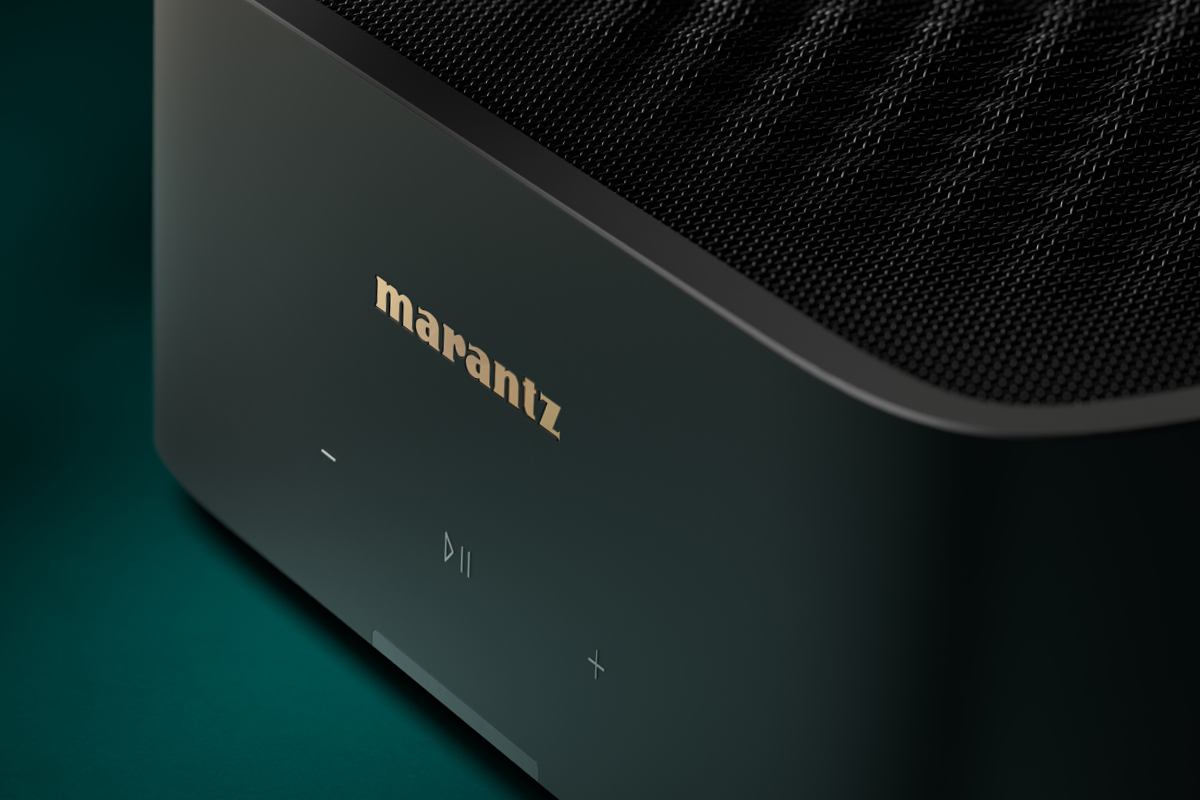Close your eyes for a second and envision the Platonic ideal of a streaming amplifier. Then open them again and keep reading. You probably pictured something along the lines of the NAD C 700, right? Or maybe the Cambridge Audio CXN100? Or the SVS Prime Wireless Pro SoundBase? In other words, a black box with either a touchscreen or at least a digital display.
Or maybe your brain leans more toward the vibe of the WiiM Amp Pro, which eschews the screen and goes for a more versatile but prominent volume / control knob / button kinda thing.
By contrast, the new Marantz M1 ($1000, all prices USD) looks positively minimalist, given its complete lack of screen or knob or what have you. In fact, your eye isn’t even drawn to the touch controls on the front (a mere three of them: Play/Pause, +, and −) due not only to their light silk-screening, but also the utterly hypnotic but subtle wave-interference pattern created by the woven-mesh top panel, which replaces the typical slits that serve as ventilation on most amps.
Built in Shirakawa, Japan, this little streaming amp is a sight to behold. But only if you really look at it closely. It doesn’t draw much attention to itself, although when it catches a raking light just the right way—especially in a dimly lit room—it has the sort of vibe you expect from an Apple product, albeit a matte-finished nearly black one. It also shares a lot of design language with Sonos’s pithily named Amp ($699).
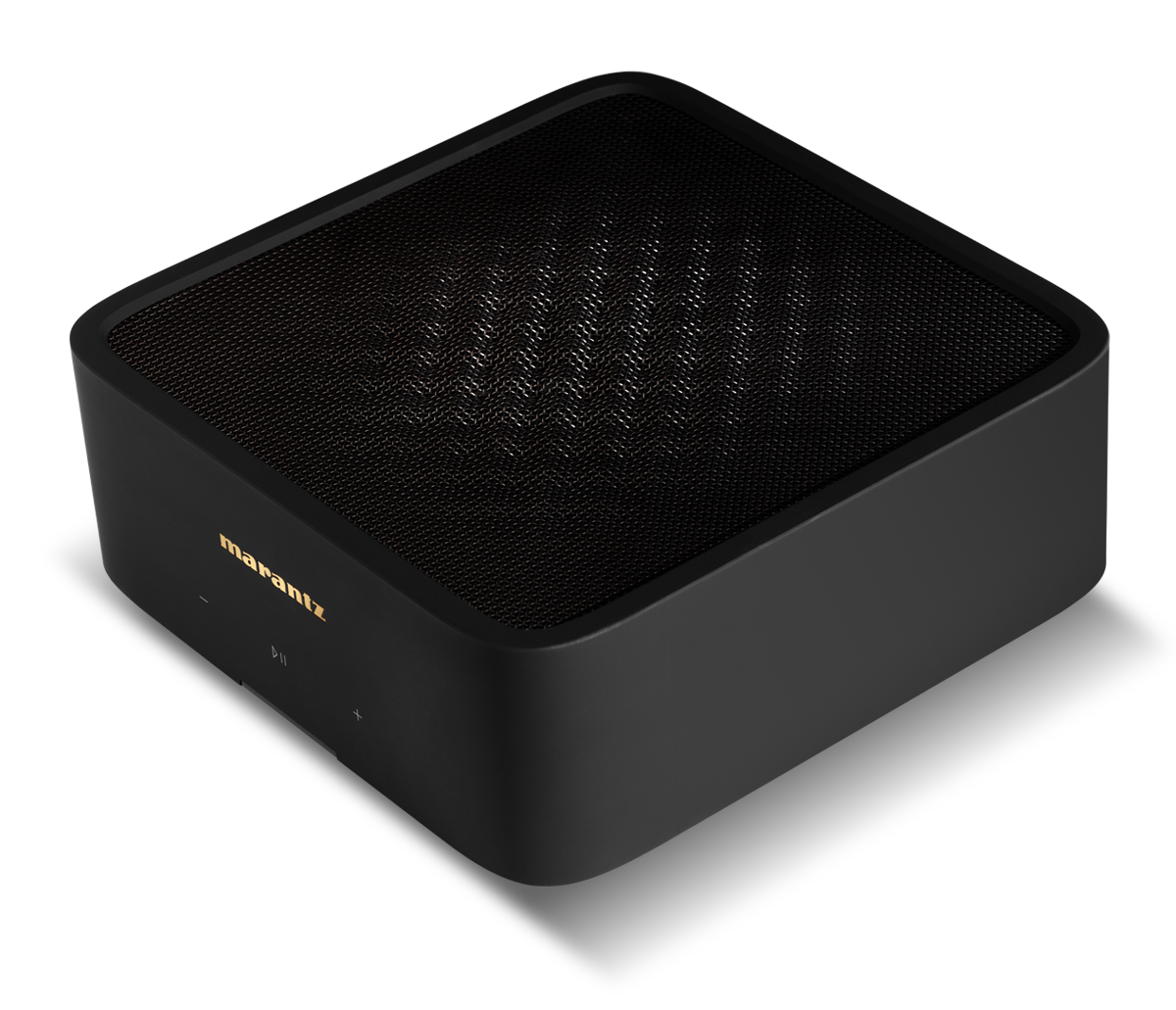
But hold your horses a second. This isn’t merely a streaming stereo amplifier. At least not in the traditional sense. (And it pains my weary old bones to call anything in this category “traditional,” but so be it.) As is becoming increasingly common in this space, the Model M1 is also a stereo A/V receiver with Dolby Digital decoding capabilities, not to mention a dedicated subwoofer output with surprisingly advanced bass management.
Inside and out
The Model M1 also has an interesting topology and signal path. Unlike most class-D implementations, it’s digital from end to end, meaning even if you plug an analog source into its line-level input, it’ll be digitized. The amp stage is specified to deliver 100Wpc into 8 ohms or 125Wpc into 4 ohms (0.05% THD), and while its output into 4 ohms would concern me if this were a class-AB amp, perhaps indicating a wimpy power supply, that’s not as much a concern with switching amps—at least not as a rule. The proof is really in the listening (or measuring, of course).
The amp features an HDMI eARC port for connection to a smart TV, along with a line-level input (no phono stage, sadly), an optical digital input, a mono subwoofer out, a 3.5mm IR input, an ethernet port, and dual-band Wi-Fi (802.11 a/b/g/n/ac).
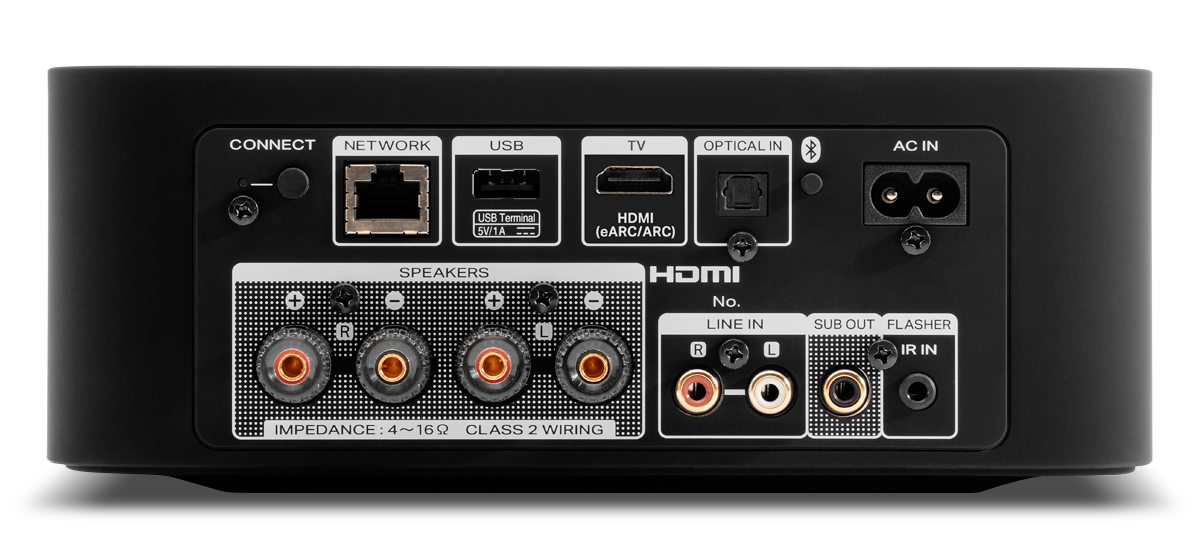
There’s also, of course, a pair of binding posts that wiggle and flex a bit too much for my comfort. Were this M1 mine to keep, I think I’d go with a bare-wire connection instead of the pre-terminated banana plugs at the end of my Elac Sensible speaker cables, as their weight caused the post to visibly sag a bit and I’d be worried about something snapping internally. But other than that, the M1 looks quite sturdy.
Setup and software
There’s no remote control and, as mentioned above, no front-panel touchscreen, meaning most of the experience of configuring and using the Model M1 is tied to its reliance on the HEOS operating system. File format support includes AAC and MP3 up to 320 kbps; WMA up to 192kbps; WAV, ALAC, and FLAC up to 24bit/192kHz; and DSF and DFF 2.8 and 5.6MHz DSD. Its optical and HDMI inputs support Dolby Digital, Dolby Digital+, and LPCM.
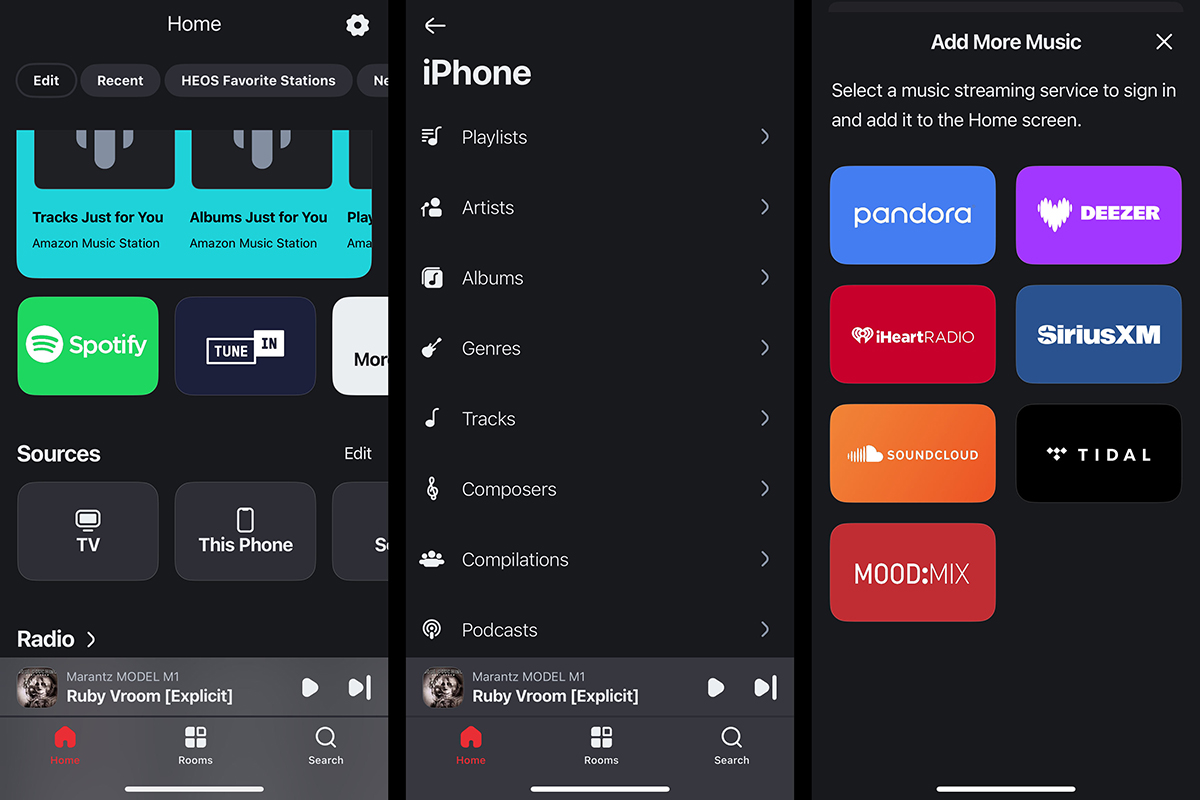
Native app support is limited to Pandora, Spotify (Connect), Amazon Music, Deezer, iHeartRadio, SiriusXM, SoundCloud, Tidal (Connect), or Mood:Mix, so you’ll need to use AirPlay 2 for Qobuz or Apple Music.
As mentioned in my review of the Marantz CD 50n, the up-to-date version of HEOS is far better than older iterations, but it’s pretty buggy at times. Newer features include a universal search function, a persistent playing-now widget at the bottom of the screen, and the ability to create mix-and-match playlists that include songs from different streaming services.
Whether or not that makes up for the dearth of app support likely depends upon which music streaming services you use on the regular. No matter which service you’re using, though, glitches frequently pop up, such as misplaced artwork, artwork that refuses to change as you launch new music, artwork that persists when you switch streaming services, and odd short-circuits where you’ll press play on an album by one artist and get a completely different album by a completely different artist, especially when using Amazon Music. Perhaps the HEOS folks are doing some tinkering on the back-end at the moment, but this is the glitchiest HEOS has been for me in quite some time.
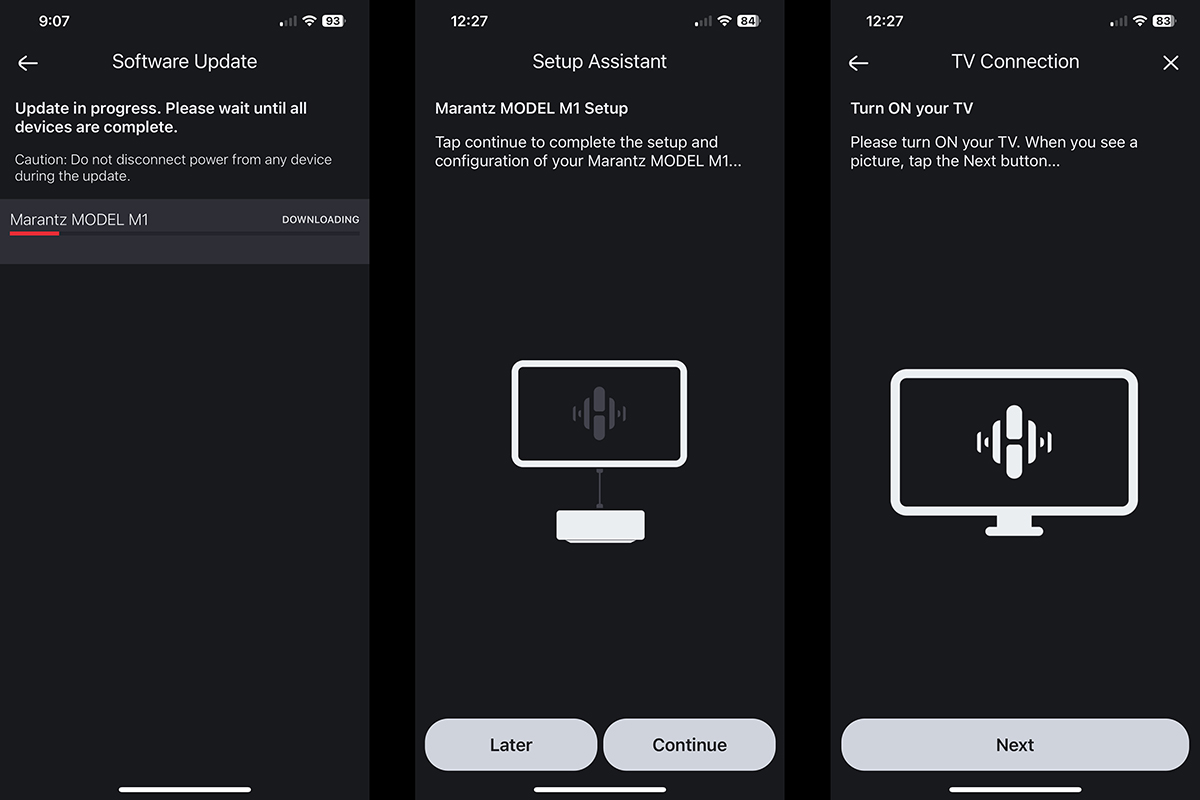
As is always the case with newer HEOS-enabled gear, though, the networking aspect of setup pretty much just sorted itself out with zero effort on my part. When I first connected the Model M1 to my network (via ethernet) and fired up the HEOS app, I was immediately met with a prompt to download and install a firmware update. On my half-gigabit cable internet connection, the download didn’t take long, but installing it did involve several automated hardware reboots and, all told, took about 13 minutes.
Immediately thereafter, the HEOS software made it abundantly clear to me that it assumed I’d be hooking the M1 to a TV and using it as a fancy soundbar as well as a stereo system. It wasn’t so much a question of whether I would, but rather how I would: via HDMI or optical digital. There’s no provision for “neither of the above,” and there’s no cheating, since the M1 is actively on the lookout for an interconnection. So I had to exit the setup wizard entirely and explore the configuration options on my own.
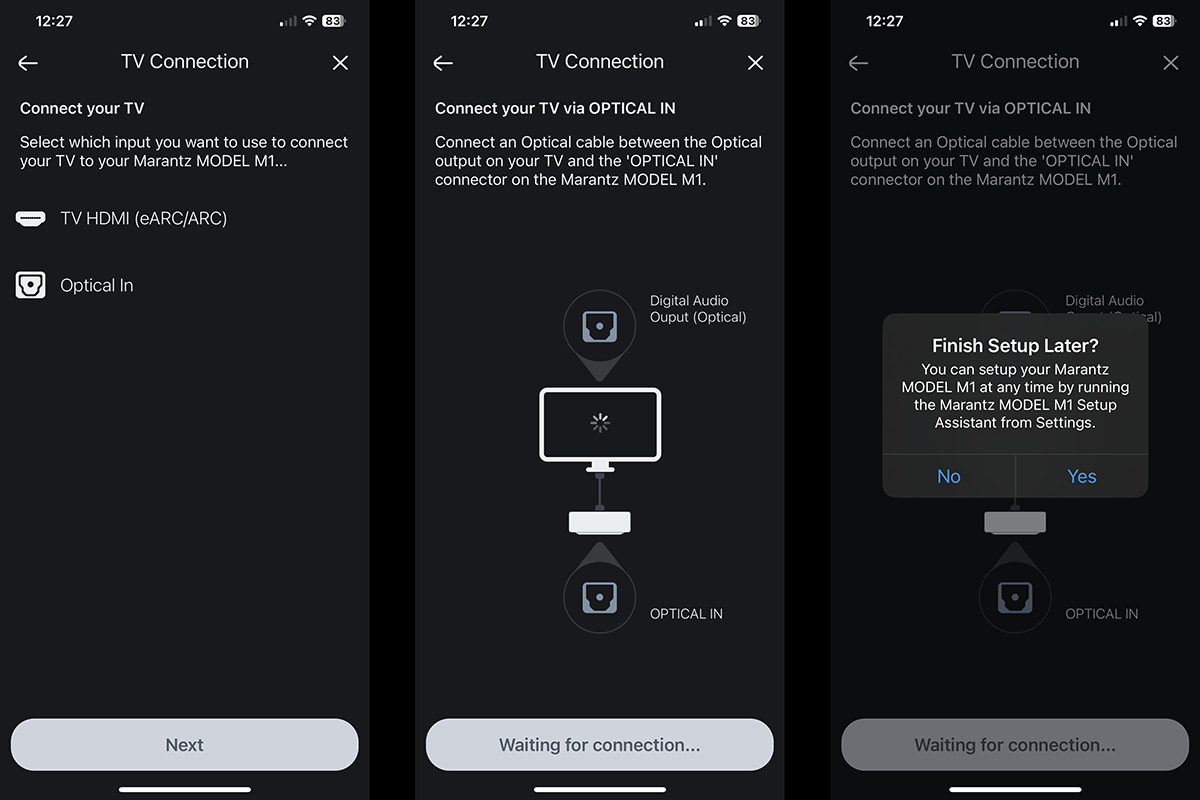
What I found was a wealth of legitimately useful configuration functionality, including not only independent high-pass and low-pass filters for bass management (40, 80, 90, 100, 110, 120, 150, 200, and 250Hz settings for the former; 40, 60, 80, 90, 100, 110, and 120Hz for the latter), but also a wizard for learning the IR codes of a third-party remote if you don’t want to use CEC, settings for volume limits, and as is becoming the norm on Marantz gear these days, your choice between two digital reconstruction filters.
Marantz describes the filters thusly:
- Filter 1 (Default): Recommended setting to enjoy the Marantz sound.
- This filter has short delay slow roll-off characteristics.
- Filter 2: Recommended setting for bench test measurements.
- This filter has sharp roll-off characteristics.
Pretty safe to assume that Filter 1 is a minimum-phase filter and Filter 2 a linear-phase design, neither of which is as consequential as the order of the roll-off. At any rate, their arrangement and naming are the opposite of what I’ve experienced in most Marantz gear with selectable filters here lately. What really took me by surprise, though, is just how different the two filters sound in actual practice. That’s generally not the case, even for filters as technically different as these two, but as we’ll discuss in the listening notes below, you’ve basically got two very different-sounding streaming integrated amps in one chassis here.

One other important setting worth noting is that the sound effects tied to the touch-sensitive front-panel controls can thankfully be turned off. I wish they could be attenuated instead of merely turned on or off, because getting some feedback is nice. But your only options here are silence or a loud, transient CLACK that must have been designed by the UX-development department located in the ninth circle of hell. So “Off” it was.
For the duration of the review, I had the Model M1 connected to my Paradigm Studio 100 v.5 tower speakers. I briefly added an SVS PB-1000 Pro sub to the setup to test the bass management, which proved to be as delightfully flexible and comprehensive as its many settings would indicate. It quickly became apparent, though, that eschewing the sub gave me a much better sense of the amp’s capabilities. So the bulk of my listening was done in stereo.
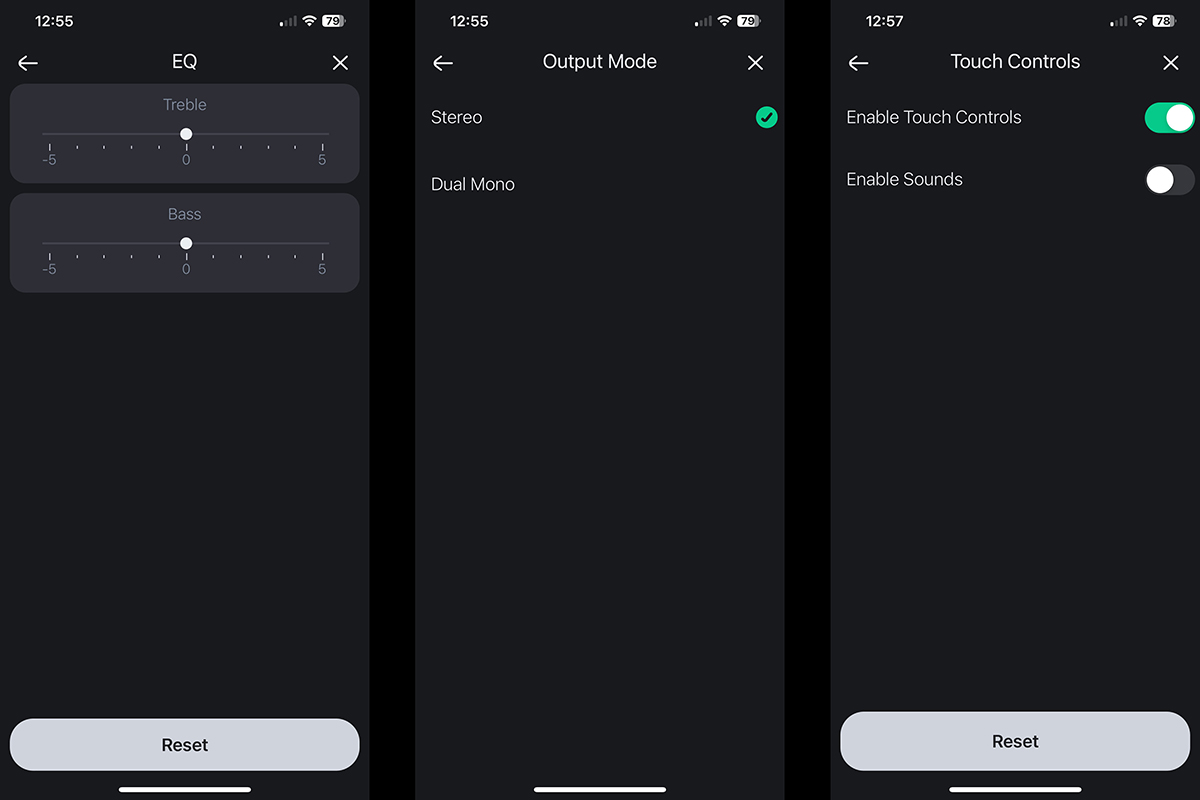
Listening impressions
It took no more than a few seconds of listening to “Uh, Zoom Zip” from Soul Coughing’s Ruby Vroom (16-bit/44.1kHz ALAC, Roundhill Records / Apple Music) via AirPlay to recognize that the power supply in this little amp is a rampaging beast, and I mean that in the best possible way.
The bass coming out of my Paradigm towers was shocking in its authority and control. I could feel it in my soul as much as my tummy. Granted, I couldn’t get the volume any higher than 50 percent in my relatively small listening room without feeling actual physical discomfort, but that was more than enough to know that the Model M1 can easily plow through any of my speakers’ impedance dips, especially in the lower frequencies.
It wasn’t merely the power of the bass that impressed. The nuance here was appreciable. It was the exact opposite of one-note bass, in that even the deepest notes were melodically distinct and the fundamental of every note was clearly audible.
And the rest of the audible spectrum followed suit. The slap and rattle of the bass strings, the clack and bap of the drums, the nasally harmonics of Mike Doughty’s inimitable voice—all of it was delivered with every ounce of texture and clarity you could hope for.
Looping back around the album to the song before “Uh, Zoom Zip,” I found that “City of Motors” was the perfect track for experimenting with the Model M1’s two selectable filters. Engaging Filter 2, which Marantz says is the “recommended setting for bench test measurements,” better preserved the transients that are so crucial to delivering the percussive smack of this track. Overall, the entire experience of the song was more appropriately aggressive, not to mention more spacious and tangible.
Filter 1, by contrast, toned down some of the aggression and minimized the spaciousness of the mix, but only a little, and it also made for a more euphonic listening experience I think a lot of people would dig. As mentioned above, I rarely hear this much difference between two filters in a product that includes more than one. I especially don’t expect this much audible difference in Marantz filters. And my biases are such that, given how different they are, I should hate one of them. But I don’t. Filter 2 sounded more accurate to my ears and was far and away my preference with this album, but Filter 1 had a vibe that I quite liked, too. Maybe I’m getting mellower in my old age.
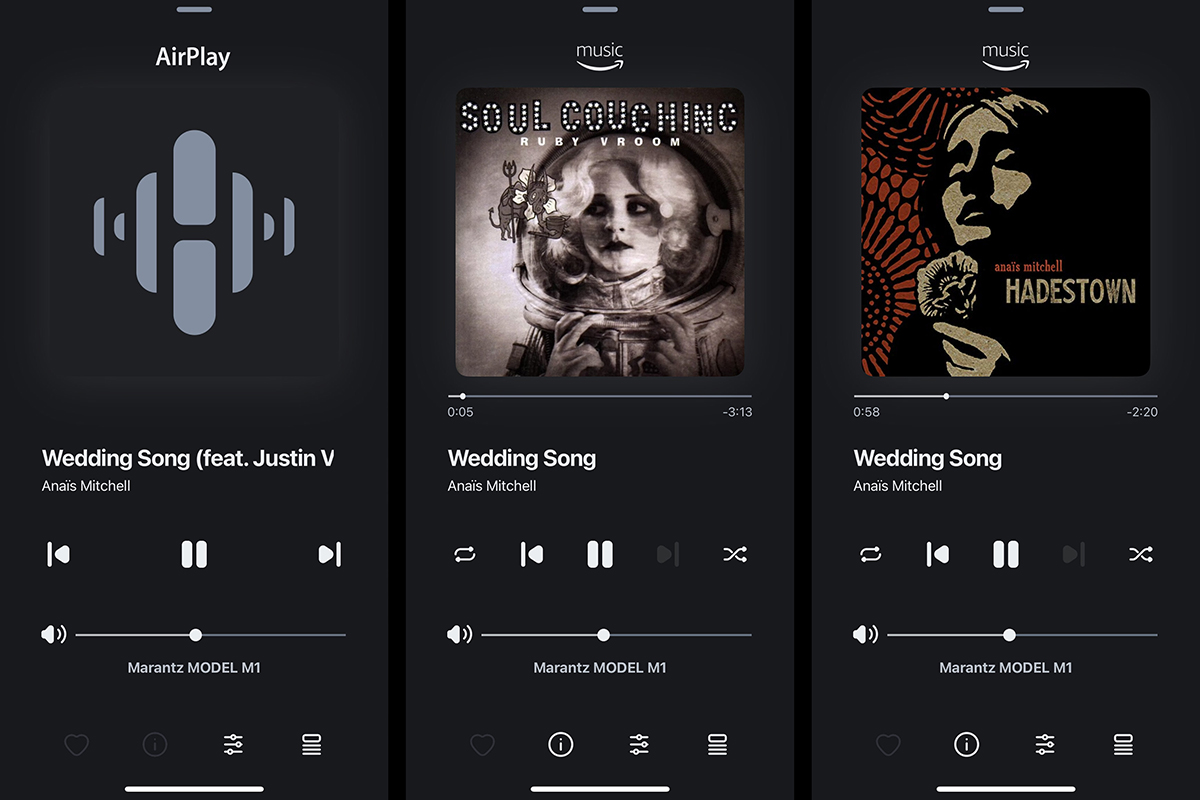
What’s strange is that I had the exact opposite experience with “Wedding Song (feat. Justin Vernon)” from Anaïs Mitchell’s 2010 album Hadestown (16/44.1 ALAC, Wilderland Records / Apple Music), at least with regard to filter preference. Mitchell’s voice, if you’re unfamiliar, has a distinctive edge that can get a little too biting at much higher listening levels than you’d normally subject this sort of Americana music to. But switching over to Filter 1 (the slow roll-off, minimum-phase filter) smoothed over some of those edges without depriving the song of any of its sense of space, and without diminishing textures like the sound of fingers being dragged across bronze guitar strings. Either way, soundstaging and imaging were absolutely sublime.
So while there’s no doubt that Filter 1 must start rolling off somewhere in the neighborhood of 10–12kHz (my sensitivity to higher frequencies plummets at somewhere around 16kHz, after all), and while I’m normally averse to such heavy-handed filtering, I kept finding myself loving its effects with certain tunes, and loving even more the ability to immediately switch between the filters and to get to that setting in more than one way via the HEOS app.
Of course, the filtering does nothing to the lower frequencies, and here again the Model M1 excelled, delivering rich, deep, impactful and nuanced bass of the sort that indicates a well-designed power supply and low output impedance.
Comparisons
If you’re already locked into the HEOS ecosystem and you’re looking to spend $1000 on a stereo integrated amplifier with A/V connectivity, the Model M1, surprisingly, isn’t your only Marantz option. There’s also the new Stereo 70s, which offers a lot more connectivity and functionality for the same price. It has a more traditional slimline design in keeping with Marantz’s modern design language, and it features A and B speaker outputs, dual subwoofer outs, six HDMI inputs (three of them 8K-capable!), an MM phono stage, and a remote control. It’s also Roon Tested. It doesn’t, however, employ the same amp topology, and it delivers just 75Wpc of class-AB power.
A more comparable competitor would probably be the Bluesound Powernode ($949), although of course that means a switch to BluOS as your streaming ecosystem, which gives you more baked-in streaming-service support and less-glitchy performance, but no local phone-library support natively. At 80Wpc into 8 ohms, rated power is slightly lower than the Model M1, although frankly, that’s more than enough for most people in most rooms.
The tiny little elephant in the room, though, is the WiiM Amp Pro ($379), which doesn’t offer as nice a form factor, for sure, but its LinkPlay streaming audio ecosystem stomps the snot out of HEOS, with support for way more services (pretty much everything you’d want except Apple Music). The amp boasts features you wouldn’t expect at this price, including a ten-band parametric EQ, Bluetooth 5.3 LE, and an adjustable crossover for the sub. It doesn’t have the separate high- and low-bass filters for bass management you get from the Marantz, its output is limited to 60Wpc into 8 ohms (120Wpc into 4 ohms, though, with minimum impedance down to 2.67 ohms), and it doesn’t feature AirPlay 2 connectivity, although oddly the cheaper WiiM Amp does.
Conclusion
It’s a bold move for Marantz to release a product like the Model M1, because while the market is obviously gravitating toward offerings with similar form factors and functionality, it’s already a crowded space. With stiff competition coming in for somewhere around a third of the price, the M1 has to find other ways of justifying the number on the sticker than merely features and specs.
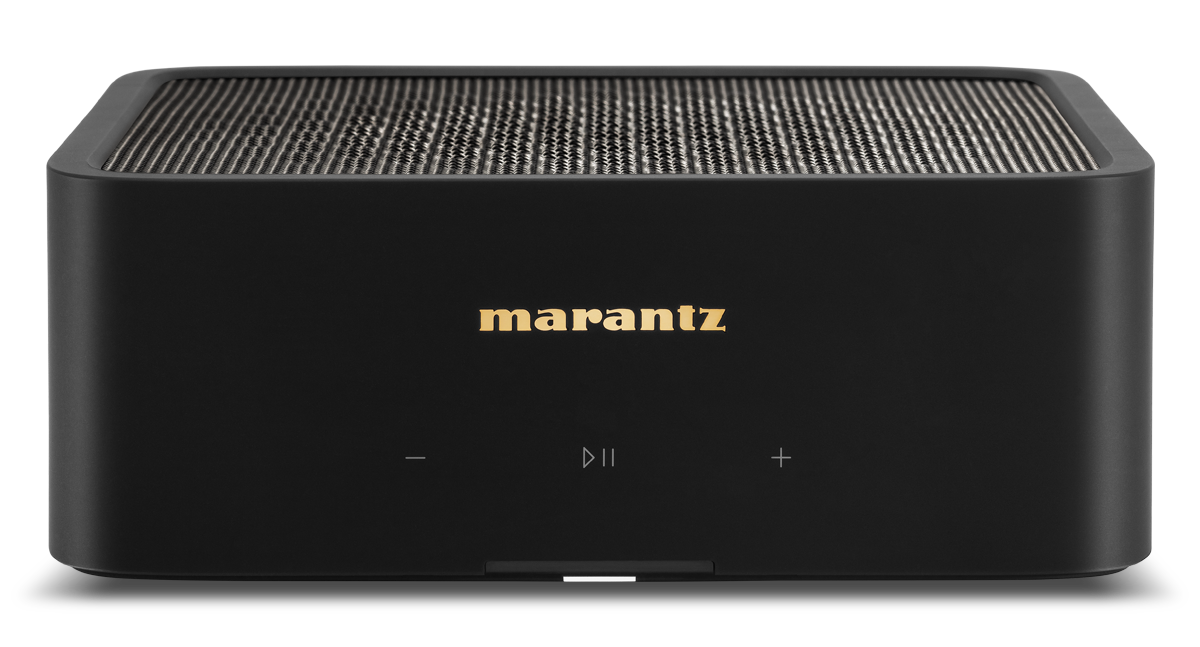
The direct-digital architecture is one such way. The subtle-but-distinctive styling is another. It has to be said, though, that the effectiveness of the Model M1 ultimately hinges upon HEOS as a multiroom streaming music ecosystem, and as I write this, it’s the amp’s weakest feature. HEOS has, as I’ve said numerous times, improved by leaps and bounds recently. And I’d rather use it than Sonos at this point. Or at least I would if it supported Qobuz. But it’s still a buggy mess of a thing with limited functionality and more than its fair share of curious quirks.
It’s a shame, because with the right operating system, the Model M1 would be hard to resist, especially given its good looks, its ease of use, and the fact that it could drive a dump truck around the Nürburgring Nordschleife at top speed without breaking a sweat. As it stands, though, this gorgeous streaming amp is likely irresistible only to those who’ve already bought into a whole home’s worth of HEOS or are perfectly content to just use AirPlay (which, I’ll admit, I totally am).
. . . Dennis Burger
Associated Equipment
- Speakers: Paradigm Studio 100 v.5
- Speaker cables: Elac Sensible
- Sources: iPhone 12 Pro Max
- Power protection: SurgeX XR115
Marantz Model M1 streaming integrated amplifier
Price: $1000
Warranty: Five years, parts and labor
Marantz c/o Masimo Consumer
5541 Fermi Ct.
Carlsbad, CA 92008
Phone: (844) 298-5032
Website: marantz.com



